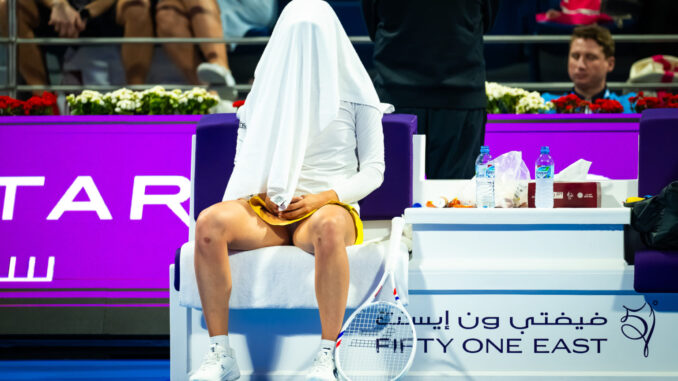
The world of professional tennis is a stage where fortunes can shift in the blink of an eye, where strategies are constantly evolving, and where even the most steadfast pronouncements can be subject to change. Iga Swiatek, a dominant force in women’s tennis, recently found herself navigating this dynamic landscape during a match against Jelena Ostapenko. The encounter, a captivating blend of skill and resilience, saw Swiatek ultimately succumb to Ostapenko’s aggressive play. However, it wasn’t just the defeat itself that caught attention; it was a particular instance during the match where Swiatek appeared to contradict a previous statement, a moment that underscored the fluid nature of competition and the challenges of adhering to pre-conceived plans.
Days prior to the match, Swiatek had articulated a specific approach she intended to take against Ostapenko, a player known for her unpredictable and often high-risk style of play. Swiatek, typically a picture of composure and strategic precision, emphasized the importance of maintaining her composure and sticking to her game plan, even when faced with Ostapenko’s often disruptive tactics. She spoke about the need to avoid getting drawn into Ostapenko’s chaotic rhythm, to resist the temptation to deviate from her own well-structured approach. This declaration, while seemingly straightforward, hinted at the mental challenge of facing such an unorthodox opponent.
The match against Ostapenko unfolded as a compelling narrative, a clash of styles that showcased the best and sometimes the most frustrating aspects of both players’ games. Ostapenko, true to form, unleashed a barrage of powerful shots, frequently disrupting Swiatek’s rhythm and forcing her out of her comfort zone. Swiatek, initially appearing determined to stick to her stated strategy, found herself increasingly under pressure. As the match progressed, the strain began to show, and Swiatek’s composure, so vital to her game, seemed to waver.
It was during a particularly crucial moment in the match that Swiatek appeared to contradict her earlier pronouncement. Faced with a series of aggressive returns from Ostapenko, Swiatek, instead of maintaining her usual measured approach, seemed to engage in a more reactive style of play. She appeared to abandon, at least momentarily, the strategy she had outlined just days before. This shift in tactics, while perhaps subtle, was noticeable and raised questions about the challenges of sticking to a pre-conceived plan when faced with the intense pressure of competition.
The incident highlights the inherent difficulty of predicting how a match will unfold. Even the most meticulous planning can be disrupted by the unpredictable nature of sport. Opponents have their own strategies, their own strengths, and their own ways of challenging a player’s approach. In Swiatek’s case, Ostapenko’s aggressive style clearly presented a significant hurdle, testing Swiatek’s resolve and forcing her to adapt.
The fact that Swiatek deviated from her stated strategy is not necessarily a criticism. In fact, it could be seen as a testament to her adaptability and her ability to make adjustments mid-match. Tennis is a dynamic sport, and players must be able to react to the ever-changing circumstances on the court. Sometimes, sticking rigidly to a plan can be detrimental, and the ability to deviate and improvise can be a sign of strength.
The incident also underscores the psychological aspect of professional sports. The pressure to perform, the weight of expectations, and the constant scrutiny can take a toll on even the most seasoned athletes. In Swiatek’s case, the pressure of facing a challenging opponent, coupled with the weight of her own pre-match pronouncements, may have contributed to her decision to deviate from her initial strategy.
The match against Ostapenko served as a reminder that even the best-laid plans can go awry. It highlighted the unpredictable nature of sport and the importance of adaptability. Swiatek’s experience underscores the challenges of sticking to a pre-conceived strategy when faced with the intense pressure of competition and the unpredictable nature of an opponent’s game. It’s a testament to the fact that even the most dominant players are constantly learning, adapting, and evolving their approach. The ability to adjust, to deviate when necessary, and to learn from every experience is what ultimately defines a true champion. Swiatek’s journey continues, and her capacity to learn and evolve will undoubtedly contribute to her future success.
Leave a Reply